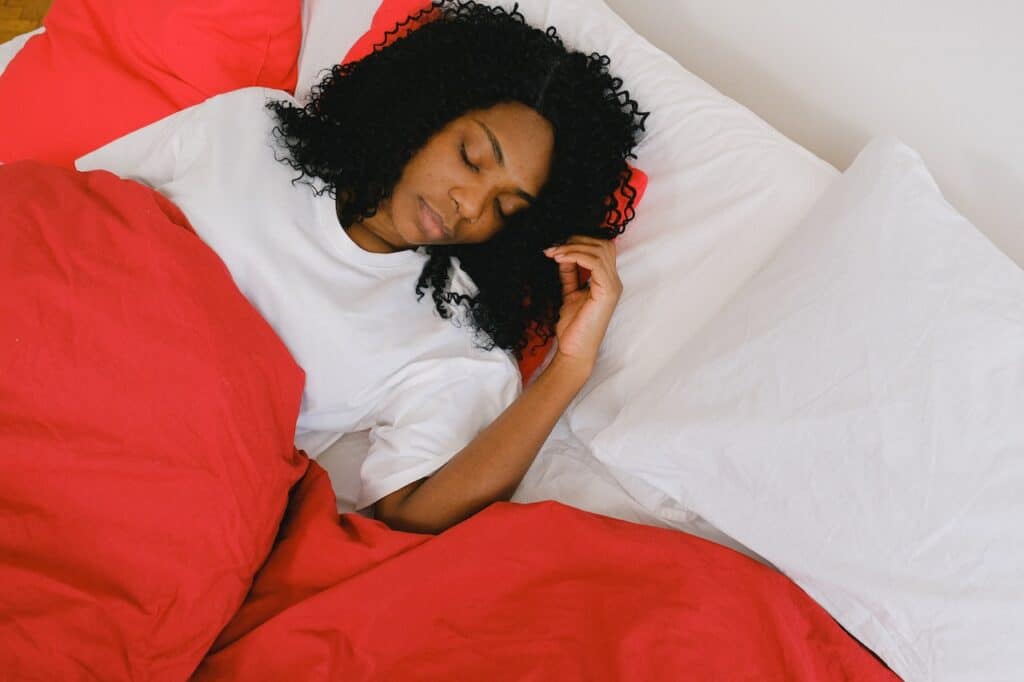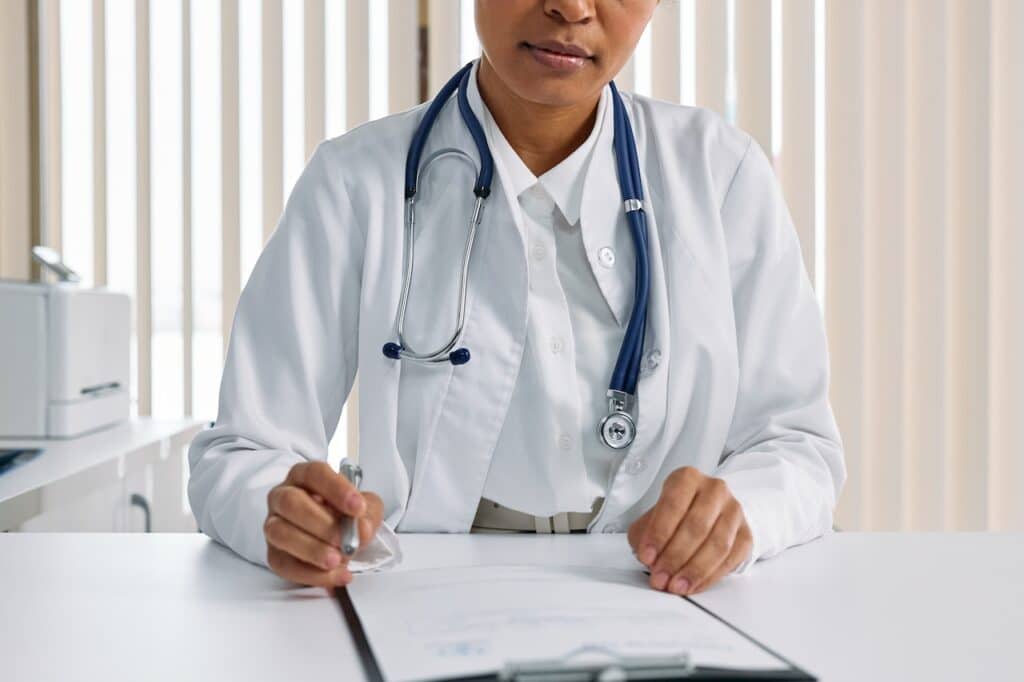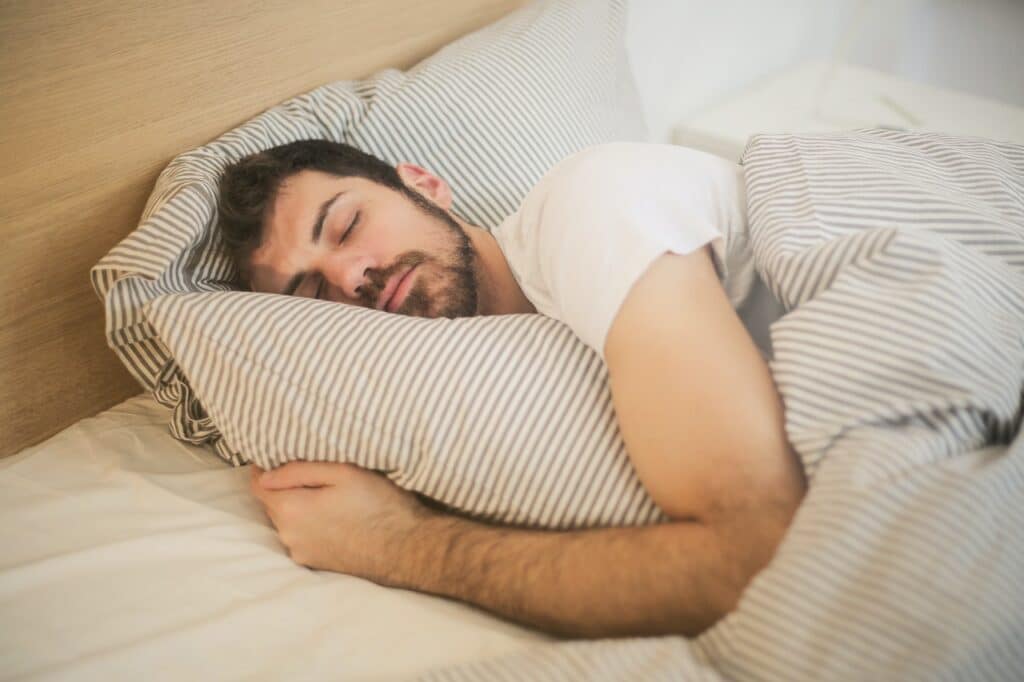Sleep apnea, specifically obstructive sleep apnea, is a sleep disorder marked by breathing pauses during sleep. If untreated sleep apnea persists, it could increase the risk factors for conditions like heart disease, heart attack, excessive daytime sleepiness, and Type 2 diabetes. This guide outlines the common symptoms and signs of sleep apnea, the sleep study methods used for diagnosis, and the treatment options available.
What is Sleep Apnea?
Sleep apnea is a common sleep disorder where people experience breathing pauses during sleep, often due to obstructions like the tongue, soft palate, or uvula shifting positions.
Loud snoring and gasping during sleep are common symptoms, while daytime sleepiness, morning headache, and dry mouth are other signs of sleep apnea.
According to the American Sleep Apnea Association, roughly 30 million American adults suffer from obstructive sleep apnea. If left untreated, sleep apnea may escalate risk factors leading to high blood pressure, heart disease, and other health complications. However, with the proper sleep apnea treatment and guidance from a sleep specialist, the condition is manageable.
Types of Sleep Apnea
There are three primary forms of sleep apnea: obstructive sleep apnea (OSA), central sleep apnea, and complex sleep apnea. The most prevalent of these is obstructive sleep apnea.
Obstructive Sleep Apnea—The majority of people with sleep apnea symptoms suffer from OSA.
This sleep disorder arises when structures in the breathing pathway, such as the tongue or uvula, move and obstruct the airway during sleep. Breathing pauses typically happen for 10 seconds or more, and recur five to 30 times per hour. OSA is most frequently associated with those who have a higher risk factor for sleep obstructions, such as obesity.
Central Sleep Apnea—Central sleep apnea is less common, and occurs when the brain doesn’t alert the respiratory muscles to take a deep breath in response to increasing carbon dioxide levels. People with central sleep apnea exhibit slower and more shallow breathing patterns than usual.
Complex Sleep Apnea—When someone exhibits signs of both obstructive sleep apnea and central sleep apnea, it’s referred to as complex sleep apnea. On occasion, people undergoing treatment with continuous positive airway pressure for OSA may develop central sleep apnea symptoms.

Signs of Sleep Apnea
Review these signs of sleep apnea to determine if you’re suffering from this sleep disorder.
Common symptoms or health issues related to sleep apnea include:
- Loud snoring—More prevalent in obstructive sleep apnea, but not everyone who snores has sleep apnea.
- Breathing pauses—This is often noticed by another person who might see the person stop breathing for several seconds during sleep.
- Choking or gasping for air during sleep—Following a pause in breathing.
- Excessive daytime sleepiness (EDS)—People often feel very drowsy during the day, even if they’ve had a full night’s sleep.
- Difficulty concentrating during the day—Due to disrupted sleep.
- Morning headache—Regularly waking up with a headache.
- Dry mouth or sore throat upon waking—This can be due to breathing through the mouth during sleep or snoring.
- Difficulty staying asleep—Waking up frequently during the night.
- Irritability or mood changes—Due to lack of restful sleep.
- High blood pressure—Sleep apnea can be a risk factor for hypertension.
It’s essential to note that while these symptoms can be indicative of sleep apnea, they can also be associated with other medical conditions or lifestyle factors. If someone suspects that they have sleep apnea, it’s crucial to see a sleep specialist or undergo a sleep study to get a proper diagnosis.
Fact: Women are more likely to report signs of sleep apnea, such as excessive daytime sleepiness, morning headache, and mental health issues like anxiety and depression.
What Causes Sleep Apnea?
Risk factors that contribute to sleep apnea include medical conditions, genetics, and certain body structures. Being overweight remains the most common risk factor for sleep apnea.
Common sleep apnea causes include:
- Genetic predisposition—Certain conditions that affect the facial and skull structures, like a tongue positioned further back in the mouth, a cleft lip or Down syndrome, can cause sleep apnea symptoms.
- Heart or kidney failure—Fluid accumulation in the neck due to heart failure or kidney failure could result in airway obstructions.
- Hormone disorders—Conditions such as hypothyroidism, polycystic ovary syndrome, and elevated growth hormone levels (as seen in acromegaly) have been linked to sleep apnea.
- Large tonsils—An enlarged tonsil can narrow the upper respiratory pathway, leading to apnea symptoms.
- Neuromuscular conditions—Disorders like strokes, Chiari malformations, myotonic dystrophy, and myasthenia gravis could interfere with chest muscle function and brain signals that control the airway, triggering sleep apnea.
- Obesity—Accumulation of fat in the neck region can obstruct the breathing pathway.
- Premature birth—Infants born prematurely have an increased risk for breathing irregularities. However, this risk is reduced as they grow and their central nervous system matures.
Sleep Apnea Risk Factors
Some risk factors for sleep apnea, such as weight and certain lifestyle choices, can be managed, while others like age or genetics are beyond one’s control. It’s crucial to consult with a sleep specialist or doctor regarding your risk factors and potential strategies to mitigate the onset of
sleep apnea.
- Age—While sleep apnea is possible at any age, it’s more prevalent among middle-aged and older individuals.
- Sex—Men are generally more susceptible to sleep apnea than women, though the risk for women increases after menopause.
- Heredity—Those with a family history of sleep apnea have an increased risk of sleep apnea. Certain genetic conditions can further increase this risk.
- Lifestyle—Consumption of alcohol or the use of sedatives can cause the throat muscles to relax, exacerbating obstructive sleep apnea symptoms. Additionally, smoking causes inflammation in the airway. A smoker’s risk for sleep apnea is three times higher than a non-smoker.
Screening for Sleep Apnea
Medical professionals may screen for sleep apnea using questionnaires that ask about signs of sleep apnea, which include symptoms like loud snoring, high blood pressure, and daytime sleepiness. Currently, primary care doctors don’t routinely screen for obstructive sleep apnea.
When people mention potential sleep apnea symptoms to their healthcare providers, they are typically directed to a sleep specialist for a more thorough assessment. Yet, only a fraction (around 20%) of patients talk to their doctor about their sleep patterns.
The U.S. Preventive Services Task Force published its recommendations for sleep apnea screening in JAMA, a medical journal, on Nov. 15, 2022. According to the article, “The current evidence is insufficient to assess the balance of benefits and harms of screening for OSA in the general adult population.” Given this uncertainty, the task force isn’t currently recommending regular sleep apnea screenings.

How is Sleep Apnea Diagnosed?
In order to diagnose sleep apnea, your healthcare professional will review your family history, look for common symptoms, and evaluate any medical conditions that could be linked to sleep apnea. During the examination, they might examine areas like your neck, jaw dimensions, tongue, lungs, heart, and neurological systems for signs related to sleep apnea.
Following this, a sleep study might be recommended. A sleep study is considered the definitive method for diagnosing sleep disorders. During this study—which is typically carried out at a sleep lab—specialists will monitor your blood oxygen levels, brain activity, heart rate, and breathing patterns. Once sleep apnea is confirmed, an endoscopy may be done to pinpoint the exact location of the airway obstructions.
For some, a home test might be recommended, which offers more convenience compared to a visit to a sleep lab. However, these tests primarily focus on breathing, making them less precise. Due to this limitation, they’re typically reserved for people with moderate to severe obstructive sleep apnea symptoms.
Those with other health concerns, such as heart failure, lung disease, restless leg syndrome, hypoventilation, or central sleep apnea, are usually not deemed suitable for home-based testing.
Fact: Loud snoring is a common symptom of sleep apnea, but not all people who snore suffer from this sleep disorder.
How to Treat Sleep Apnea
People diagnosed with sleep apnea often begin their treatment journey with lifestyle modifications. In certain situations, sleep apnea can be treated if you lose weight, stop smoking, and exercise more.
Should lifestyle adjustments prove ineffective, your doctor may suggest a medical device like implants, oral appliances, or breathing machines—like the continuous positive airway pressure (CPAP) machine—to open the airway and help you breathe better.
In February 2021, the U.S. Food and Drug Administration (FDA) approved the eXciteOSA device, which uses muscle stimulation via a mouthpiece on the tongue to prevent the tongue from collapsing. Another method involves implanting a device called Inspire into your body. This device is activated using a remote control to keep the airway open while sleeping.
Custom oral devices are designed to adjust your tongue or jaw position, preventing both from obstructing your airway while you sleep.
The CPAP machine, the standard treatment option for obstructive sleep apnea, has been backed by numerous studies affirming its effectiveness. It operates by channeling pressurized air via a facemask, helping you maintain an open airway while you sleep. However, some might find the side effects of CPAP challenging to endure. In these scenarios, healthcare providers may explore alternative treatments, including surgical interventions, to clear airway obstructions.
Sleep Apnea Treatment Options
- Lifestyle Changes:
- Losing weight for those who are overweight
- Avoiding alcohol and sedatives before bedtime
- Sleeping on the side instead of the back
- Quitting smoking
- Continuous Positive Airway Pressure (CPAP): A machine that delivers air pressure through a mask, keeping the airways open.
- Oral Devices: Custom-fitted dental devices designed to reposition the tongue or jaw to prevent airway obstruction.
- Surgeries:
- Uvulopalatopharyngoplasty (UPPP) to remove excess tissue from the throat.
- Genioglossus advancement (GA) to prevent the tongue from collapsing backward.
- Maxillomandibular advancement (MMA) to reposition the jaw forward.
- Inspire therapy to stimulate the nerve that controls tongue movement.
- eXciteOSA Device: A device approved by the FDA that uses muscle stimulation through a mouthpiece on the tongue to prevent it from collapsing.
- Bi-level Positive Airway Pressure (BiPAP or BPAP): Similar to a CPAP machine, but delivers alternating levels of air pressure based on breathing patterns.
- Adaptive Servo-Ventilation (ASV): Designed for central sleep apnea, this machine adjusts the normal breathing rhythm.
- Positional Therapy: If sleep apnea is more pronounced while sleeping on the back, this therapy places a device around the waist or back to ensure the sleeper remains on their side.
- Nasal EPAP (Expiratory Positive Airway Pressure): Devices that cover the nostrils and create pressure, opening the airways.
- Nasal Congestion Treatment: If someone has difficulty breathing through the nose due to allergies or anatomical issues, treatment may involve anti allergy medications, nasal corticosteroid sprays, or nasal dilators.
The best treatment option depends on the type and severity of sleep apnea, the underlying cause, and personal preferences. It’s essential to work with a sleep specialist to determine the most suitable approach.

Philips CPAP Machine Recall
In June 2021, a major recall was announced for several sleep apnea treatment devices, including the popular Philips CPAP machines. The sound abatement foam used in these machines was at risk for breaking down. If this material was ingested or inhaled, it could cause severe health problems, including cancer and breathing issues.
Philips, one of the major manufacturers of these sleep apnea treatment devices, was hit the hardest, with millions of products included in the recall.
Subsequently, many users who experienced health issues, including those at risk for heart disease and respiratory complications, filed CPAP lawsuits, claiming that the company sold defective CPAP machines.
What if my Sleep Apnea Goes Untreated?
Sleep apnea, if left untreated, may lead to serious health consequences. Breathing pauses can result in lowered oxygen levels, and elevated blood pressure puts extra pressure on the heart, potentially impacting cardiac health over time.
Sleep apnea increases the risk for many health issues, including:
- Asthma
- Atherosclerosis (hardening of the arteries)
- Atrial fibrillation
- Cancers
- Chronic kidney disease
- Cognitive and behavioral disorders
- Gestational diabetes
- Gestational high blood pressure
- Glaucoma
- Glucose intolerance
- Heart attacks
- Heart failure
- High blood pressure
- Low birth weight
- Pancreatic damage
- Renal disorders
- Stroke
- Type 2 diabetes
Loud snoring, breathing pauses, and other signs of sleep apnea should be taken seriously. If you suspect that you may have sleep apnea, it’s important to consult with a medical professional.
Covid-19 and Sleep Apnea
Recent research has linked obstructive sleep apnea with an increased risk of severe COVID-19. However, using CPAP machines could mitigate this risk.
One study published in January 2021 in BMJ Open Respiratory Research found that people with obstructive sleep apnea and those without it had comparable risks of catching the virus. Yet, those with both obstructive sleep apnea and COVID-19 were more prone to hospitalization.
In another study, an analysis of more than 80,000 health records revealed that people with untreated obstructive sleep apnea faced a greater likelihood of infection compared to those who did not suffer from obstructive sleep apnea. However, data shared at the American Thoracic Society’s 2021 International Conference suggested that CPAP treatment could decrease infection risks for OSA patients.
References
- https://ajmc.com/view/sleep-apnea-appears-to-increase-risk-of-covid-19-infection
- https://bmjopenrespres.bmj.com/content/8/1/e000845
- https://clevelandclinic.org/health/diseases/8718-sleep-apnea
- https://fda.gov/news-events/press-announcements/fda-authorizes-marketing-novel-device-reduce-snoring-and-mild-obstructive-sleep-apnea-patients-18
- https://getstarted.inspiresleep.com/
- https://jamanetwork.com/journals/jama/fullarticle/2798399
- https://labblog.uofmhealth.org/rounds/when-a-home-sleep-apnea-test-appropriate
- https://mayoclinic.org/diseases-conditions/sleep-apnea/symptoms-causes/syc-20377631
- https://medlineplus.gov/sleepapnea.html
- https://merckmanuals.com/home/lung-and-airway-disorders/sleep-apnea/sleep-apnea
- https://nhlbi.nih.gov/health-topics/sleep-apnea
- https://sleepeducation.org/six-facts-about-sleep-apnea/
- https://stanfordhealthcare.org/medical-conditions/sleep/obstructive-sleep-apnea/diagnosis.html
